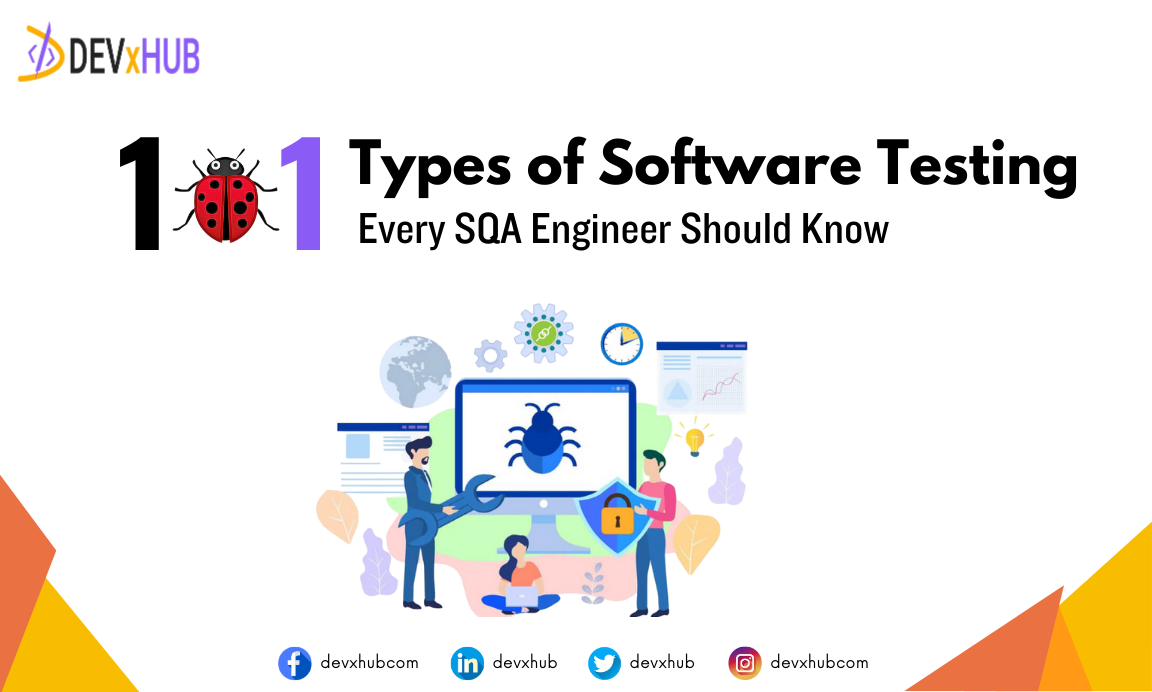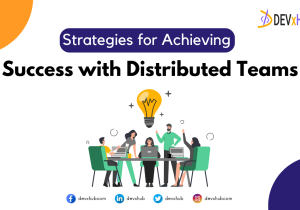Blog - 101 Types of Software Testing Every SQA Engineer Should Know 🧪🕵️♂️
Software Quality Assurance (SQA) Engineers play a vital role in ensuring the quality and reliability of software products before they reach users. With the evolving technology landscape, the range of software testing methods has expanded dramatically. Here’s a comprehensive list of 101 types of software testing, each with a brief description to give you an overview of the testing landscape. 🚀
1-20: Traditional Testing Techniques 🧪
1. Unit Testing🧩: Testing individual components or functions to ensure they work as expected.
2. Integration Testing🧩🧩: Verifying interactions between integrated components to uncover interface issues.
3. System Testing🏢: Testing the entire system to validate its compliance with requirements.
4. Acceptance Testing🙌: Ensuring the software meets user expectations and business requirements.
5. Smoke Testing🚬: A preliminary test to ensure the core functionalities are working.
6. Regression Testing🔁: Repeating tests to check if new changes affect existing functionalities.
7. Load Testing🏋️♂️: Evaluating the system’s response under expected and peak loads.
8. Performance Testing📈: Measuring the software’s speed, stability, and responsiveness.
9. Stress Testing💥: Pushing the system beyond its limits to identify breaking points.
10. Usability Testing 🤔👨🦱: Assessing user-friendliness and ease of use.
11. Security Testing🔐: Identifying vulnerabilities and ensuring data protection.
12. Compatibility Testing🔄: Checking software compatibility across different devices and platforms.
13. Exploratory Testing 🔍: Unscripted testing to discover defects through creative exploration.
14. Ad Hoc Testing🗂️: Unplanned testing without formal test cases.
15. Boundary Testing⛔️: Testing at the limits of acceptable input values.
16. Negative Testing🚫: Evaluating the software’s behavior when faced with incorrect or unexpected inputs.
17. Positive Testing✅: Testing with correct inputs to ensure expected outcomes.
18. Alpha Testing📝🧑💻: In-house testing before releasing to a limited audience.
19. Beta Testing 🚧👥: Testing with a larger group of external users.
20. White Box Testing 📦🕵️♂️: Testing based on the internal structure of the software.
21-40: Modern Testing Approaches 🌐
21. Black Box Testing📦🕵️♂️: Testing without knowledge of the internal structure.
22. Gray Box Testing📦🕵️♂️🔍: Combining elements of both white and black box testing.
23. Mutation Testing 🦠🧬: Introducing small changes (mutations) to test the robustness of test cases.
24. Model-Based Testing 📊🔬: Creating models to generate test cases and verify system behavior.
25. Automated Testing 🤖🧪: Using scripts and tools to automate testing processes.
26. Manual Testing✋🧪: Hands-on testing by human testers to simulate user interactions.
27. Crowd Testing👥🧪: Leveraging a crowd of testers to identify issues across various environments.
28. A/B Testing ↔️🔄: Comparing two versions of a software to determine which performs better.
29. Parallel Testing ➖➖: Running tests simultaneously on different versions or environments.
30. Visual Testing 👁️📸: Validating the visual elements of the software, like UI and layout.
31. API Testing🌐📡: Testing application programming interfaces for functionality and performance.
32. Web Services Testing 🌐📡💼: Testing services that communicate over a network.
33. Database Testing 🗃️🧪: Ensuring data integrity and reliability within databases.
34.Mobile App Testing 📱📲: Testing applications on mobile devices.
35. Accessibility Testing ♿️🔍: Ensuring the software is usable by people with disabilities.
36. Localization Testing 🌍🗺️: Testing the software’s adaptability to different languages and cultures.
37. Globalization Testing 🌍🗺️🔍: Ensuring the software’s readiness for global markets.
38 Continuous Testing 🔄⚙️: Integrating testing into the continuous integration/continuous delivery (CI/CD) pipeline.
39. Shift-Left Testing ⬅️🧪: Initiating testing early in the development cycle.
40. Shift-Right Testing ➡️🧪: Extending testing into production to monitor real-world behavior.
41-60: Specialized Testing Techniques 🛠️
41. Penetration Testing🕵️♂️💻: Identifying security vulnerabilities by simulating attacks.
42. Fuzz Testing🎲🔍: Providing random data to discover vulnerabilities.
43. Compliance Testing 📝🔍: Ensuring the software adheres to industry regulations and standards.
44. Installation Testing🚀📦: Validating the software’s installation process.
45. Configuration Testing ⚙️🔧: Testing various configurations and settings.
46. Recovery Testing💾🔁: Assessing the software’s ability to recover from failures.
47. Concurrency Testing 🔄🧑🤝🧑: Evaluating how the software handles simultaneous users or tasks.
48. Destructive Testing💥🧨: Intentionally causing failures to assess the software’s resilience.
49. Interrupt Testing📴🧪: Testing the software’s response to sudden interruptions.
50. Memory Leak Testing 💽🚫: Identifying memory leaks that can degrade performance.
51. Volume Testing 📈🧪: Assessing the software’s performance with large data volumes.
52. Data Migration Testing📦🔀: Ensuring data is accurately migrated between systems.
53. Scalability Testing 📈🔗: Evaluating the software’s ability to handle increased workloads.
54. Migration Testing 🚢🧪: Testing after migrating the software to a new environment.
55. Interoperability Testing 🔄🌐: Verifying the software’s compatibility with other systems.
56. Network Testing🌐🔌: Evaluating the software’s network-related functionalities.
57. Real-Time Testing⏰🧪: Testing software that operates in real-time environments.
58. Non-Functional Testing⚙️🧪: Testing aspects like performance, security, and Scalability.
59. Positive and Negative Testing ✅🚫: Evaluating both expected and unexpected behaviors.
60. Sandbox Testing 🏖️🧪: Testing in a controlled environment to avoid production risks.
61-80: Emerging Testing Practices 🚀
61. AI-Powered Testing 🤖🧪: Utilizing AI algorithms to optimize and enhance testing processes.
62. Machine Learning Testing 🤖📈: Testing algorithms and models in machine learning applications.
63. IoT Testing🌐📡🧪: Testing software in the context of the Internet of Things.
64. Blockchain Testing🔗🧪: Testing decentralized applications built on blockchain technology.
65. Virtual Reality (VR) Testing🕶️🌐🧪: Testing software in virtual reality environments.
66. Augmented Reality (AR) Testing🌍📱🧪: Testing software overlaying digital elements on the real world.
67. Microservices Testing📦🧪: Testing independently deployable microservices.
68. Containerization Testing📦🔒🧪: Testing applications packaged in containers.
69. Serverless Testing ☁️🚫🧪: Testing code without managing the underlying infrastructure.
70. Edge Computing Testing 🌐⚙️🧪: Testing software at the edge of the network.
71. Chaos Testing ⚡🌪️🧪: Introducing controlled chaos to evaluate system resilience.
72. Explanatory Testing 🗣️📝: Documenting how tests were designed and executed.
73. State Transition Testing 🔄🚦🧪: Testing based on changes in system states.
74. Automated Visual Testing🤖👁️📸: Automating visual validation of UI elements.
75. Ethical Hacking 🕵️♂️🚫: Identifying vulnerabilities by thinking like a malicious actor.
76. Performance Profiling 📈🕵️♂️: Analyzing software performance bottlenecks.
77. Monitoring and Alerting Testing🚨🔍: Testing monitoring and alert systems.
78. Continuous Monitoring 🔄🔍⚙️: Continuously assessing system performance.
79. Synthetic Testing🤖🔧: Simulating real user interactions for testing.
80. Static Analysis 📚🕵️♂️: Analyzing code without executing it to find defects.
81-101: Advanced Testing Strategies 🌠
81. Predictive Testing 🔮🧪: Forecasting potential software issues using data analysis.
82. Test Oracles 📖🧪: Mechanisms to determine expected outcomes for testing.
83. Resilience Testing 💪🛡️🧪: Testing the software’s ability to handle disruptions gracefully.
84. Continuous Security Testing🔒🔄🕵️♂️: Integrating security tests into CI/CD pipelines.
85. Automated Code Review🤖📝🕵️♂️: Using tools to identify code quality issues.
86. Test-Driven Development (TDD) 📖🧪📝: Writing tests before writing code.
87. Behavior-Driven Development (BDD) 📖🧪📝: Writing tests in a more human-readable format.
88. Model-Driven Testing 📊🔍🧪: Using models to generate test cases and validate software.
89. Cloud-Based Testing ☁️🔍🧪: Testing in a cloud environment to enhance scalability.
90. AI-Driven Exploratory Testing 🤖🔍🧪: Utilizing AI to enhance exploratory testing.
91. Automated Accessibility Testing ♿️🤖🧪: Automating checks for accessibility compliance.
92. Neural-Based Testing 🧠🤖🧪: Utilizing neural networks for testing purposes.
93. Quantum Computing Testing⚛️🧪: Testing software in the realm of quantum computing.
94. DevSecOps Testing 👨💻🔒🧪: Integrating security testing into DevOps practices.
95. Dark Launches 🌑🚀: Gradually releasing features to a subset of users for testing.
96. Mutation-Based Testing 🦠🔄🧪: Introducing code mutations to uncover weaknesses in tests.
97. End-to-End Testing 🏁🧪: Testing the entire software system from start to finish.
98. Automated Performance Testing 🤖📈🧪: Using automation to conduct performance tests.
99. Automated Security Testing🤖🔒🧪: Automating security assessments of the software.
100. User Scenario Testing 🙎♂️🙎♀️🧪: Testing based on real-world user scenarios.
101. Cognitive Testing 🧠🧪: Testing software from a human cognitive perspective.
Software Testing is a multifaceted endeavor, and SQA engineers are tasked with selecting the appropriate testing methods for their projects. This list showcases the diverse range of testing techniques available to ensure software quality, security, and reliability. As technology advances, new testing approaches will continue to emerge, enriching the landscape of software quality assurance. 🌐🛠️📱🕵️♂️🚀
Related Posts
Categories
- App Development (2)
- Design (2)
- DEVxHUB (30)
- Digital Marketing (2)
- Guide (24)
- It Bangladesh (1)
- Logo design (1)
- Operating system (1)
- Personal Improvement (14)
- Planning (4)
- Project management (3)
- Social media (2)
- Software Development (5)
- Software Quality Assurance (8)
- Startups (1)
- Team work (1)
- UI UX (1)
- Web Development (6)
Main Tags
- 2024
- Android
- app development
- bangladesh
- content writing
- design
- devxhub
- Digital marketing
- Guide
- IOS
- It
- logo design
- Operating system
- Personal Improvement
- planning
- project management
- social media
- Software Development
- Software Quality Assurance
- software testing
- software testing types
- Startups
- Success
- team
- UI UX
- UI UX design
- VR
- Web Development















